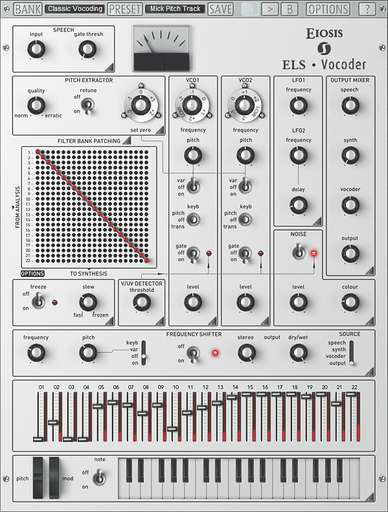MusicRadar Verdict
There´s plenty to like about this unconventional and unexpected addition to the Eiosis product range. That said, it´s neither essential nor for the faint-hearted.
Pros
- +
Looks gorgeous. Fantastic analogue sound. An experimenter’s dream. Different (it’s not another compressor plug-in!).
Cons
- -
Very high CPU usage. Doesn’t accept an external carrier source. Fixed number of filter bands. Needs more presets. No English manual (yet).
MusicRadar's got your back


Vocoders work by splitting an incoming audio signal (the modulator) into a number of frequency bands and then varying another signal (the carrier) based on the loudness of each of these bands. This means the spectral characteristics of, for example, a voice can be transferred to a synth sound. Examples can be heard on ELO´s Mr Blue Sky and many Daft Punk tracks.
The golden age of musical vocoder development was the 1970s, peaking with the release of the EMS Model 5000 in 1976. Eiosis (makers of the AirEQ plug-in) have now taken their knowledge of equalisation and filtering and applied it to vocoding: the result looks like an EMS 5000 and has many of the same controls. However, the big question is whether its sound lives up to the vintage good looks.
Features
Audio enters the plug-in via a noise gate and then proceeds to the pitch extractor. Next to this you´ll find the oscillator section - comprising twin VCOs (plus related LFO and filter ‘circuitry´), this generates the pitched carrier signal. Notes can be controlled by MIDI, detected pitch or both. A noise generator produces ‘unpitched´ carrier information. How the input controls the various sections depends on the settings of the V/UV Detector. This separates those parts of the audio that are pitched from those that are unpitched (a bit like a de-esser).
There are many extra controls to alter how the input signal influences the spectrum of the synth section, including a ‘slew´ knob and a full matrix ‘plug-board´. This part of the plug-in is actually rather daunting, and the badly translated (temporary) manual isn´t much help. Finally, there´s a frequency shifter module (for modulation effects) that can be inserted at various points.
Eiosis´s plug-in sounds different to other software vocoders we´ve used, but in a good way. However, with just a few presets, it won´t provide instant gratification, and it eats CPU. Also, you can´t use other sound sources as the carrier or alter the number of vocoding bands. Eiosis say they´ll address these issues soon, though. The key to using this plug-in is to not think of it as a conventional vocoder, but as a sound design tool that´s capable of delivering very interesting results. Try it with drums, guitar, synth or whatever you fancy. It´s hardly a studio essential, but ELS Vocoder is great if you like to experiment. There really isn´t anything else quite like it.
Want all the hottest music and gear news, reviews, deals, features and more, direct to your inbox? Sign up here.
MusicRadar is the number 1 website for music makers of all kinds, be they guitarists, drummers, keyboard players, djs or producers...
GEAR: We help musicians find the best gear with top-ranking gear round-ups and high- quality, authoritative reviews by a wide team of highly experienced experts.
TIPS: We also provide tuition, from bite-sized tips to advanced work-outs and guidance from recognised musicians and stars.
STARS: We talk to musicians and stars about their creative processes, and the nuts and bolts of their gear and technique. We give fans an insight into the actual craft of music making that no other music website can.
